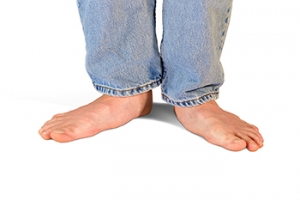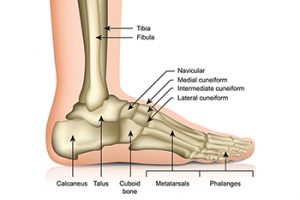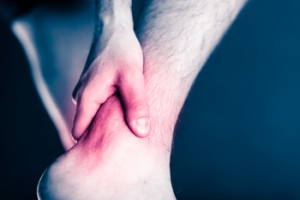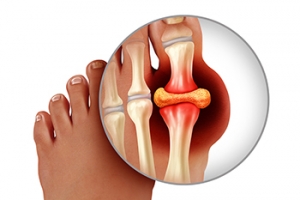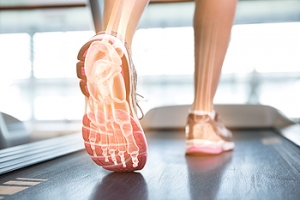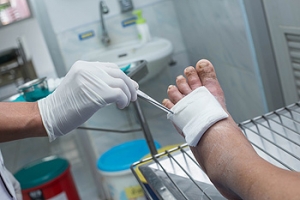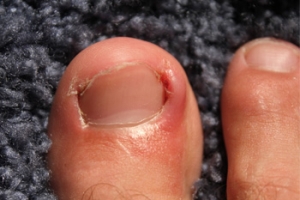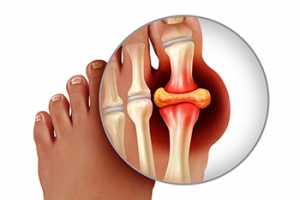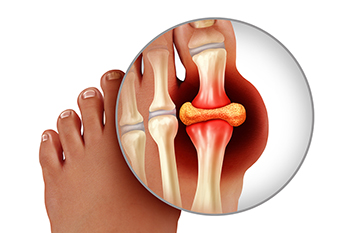Connect With Us
Featured Articles
Super User
Existing Medical Conditions May Cause Flat Feet

Having little or no arch in the foot can indicate flat feet. Flat feet can be observed while standing on the floor and checking to see if there is an arch present. People with this condition will see that their foot is lying flat against the floor with little or no space where the arch should be. Most babies are born with flat feet and the arch gradually develops at approximately age 10. Adults who have flat feet may have inherited them or have endured a foot injury. Additionally, there are existing medical conditions that can cause flat feet. These include arthritis, cerebral palsy, and spina bifida. People who are obese may notice they have acquired flat feet as a result of the weight the feet must bear. Some patients feel their weight is not distributed properly and the foot may roll inward. If you have flat feet, please consult with a podiatrist who may suggest wearing orthotics and can also show you how to perform specific exercises that can help with discomfort.
Flatfoot is a condition many people suffer from. If you have flat feet, contact Dr. Thong V. Truong from California. Our doctor will treat your foot and ankle needs.
What Are Flat Feet?
Flatfoot is a condition in which the arch of the foot is depressed and the sole of the foot is almost completely in contact with the ground. About 20-30% of the population generally has flat feet because their arches never formed during growth.
Conditions & Problems:
Having flat feet makes it difficult to run or walk because of the stress placed on the ankles.
Alignment – The general alignment of your legs can be disrupted, because the ankles move inward which can cause major discomfort.
Knees – If you have complications with your knees, flat feet can be a contributor to arthritis in that area.
Symptoms
- Pain around the heel or arch area
- Trouble standing on the tip toe
- Swelling around the inside of the ankle
- Flat look to one or both feet
- Having your shoes feel uneven when worn
Treatment
If you are experiencing pain and stress on the foot you may weaken the posterior tibial tendon, which runs around the inside of the ankle.
If you have any questions please feel free to contact our office located in Chico, CA . We offer the newest diagnostic and treatment technologies for all your foot and ankle needs.
What Is Sinus Tarsi Syndrome?
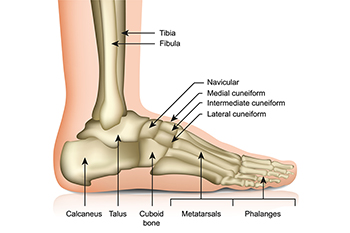
Pain on the outside of the foot between the ankle and the heel bone is usually caused by a condition known as sinus tarsi syndrome (STS). The sinus tarsi is an area within the hindfoot, between the talus and calcaneus bones, that contains ligaments, nerves, muscles, blood vessels, and fat. The pain felt in this area is generally caused by an injury to the ligament, such as a sprained ankle. It becomes a syndrome, however, when it is accompanied by several other factors. Among them are chronic pain felt at the front and side of the ankle, a feeling of instability, and difficulty walking on uneven surfaces (sand, gravel). Swelling, tenderness, and bruising are also present with sinus tarsi syndrome. People with flat feet are more likely to incur STS. It may also be the result of frequent ankle sprains. Ballet dancing, sitting with your feet tucked under you, and pitching baseballs or softballs can cause the syndrome because of repetitive actions. Symptoms of sinus tarsi syndrome generally develop over time. In order to determine whether you may have STS, please consult a podiatrist for an exam, diagnosis, and treatment options.
Ankle pain can have many different causes and the pain may potentially be serious. If you have ankle pain, consult with Dr. Thong V. Truong from California. Our doctor will assess your condition and provide you with quality foot and ankle treatment.
Ankle pain is any condition that causes pain in the ankle. Due to the fact that the ankle consists of tendons, muscles, bones, and ligaments, ankle pain can come from a number of different conditions.
Causes
The most common causes of ankle pain include:
- Types of arthritis (rheumatoid, osteoarthritis, and gout)
- Ankle sprains
- Broken ankles
- Achilles tendinitis
- Achilles tendon rupture
- Stress fractures
- Tarsal tunnel syndrome
- Plantar fasciitis
Symptoms
Symptoms of ankle injury vary based upon the condition. Pain may include general pain and discomfort, swelling, aching, redness, bruising, burning or stabbing sensations, and/or loss of sensation.
Diagnosis
Due to the wide variety of potential causes of ankle pain, podiatrists will utilize a number of different methods to properly diagnose ankle pain. This can include asking for personal and family medical histories and of any recent injuries. Further diagnosis may include sensation tests, a physical examination, and potentially x-rays or other imaging tests.
Treatment
Just as the range of causes varies widely, so do treatments. Some more common treatments are rest, ice packs, keeping pressure off the foot, orthotics and braces, medication for inflammation and pain, and surgery.
If you have any questions, please feel free to contact our office located in Chico, CA . We offer the newest diagnostic and treatment technologies for all your foot care needs.
A Partial or Complete Achilles Tendon Rupture
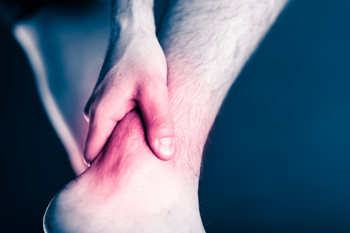
The Achilles tendon is responsible for pointing and flexing the foot, which is necessary in walking and running. It is located at the back of the heel, and connects the calf muscles to the heel. An Achilles tendon injury can occur from increasing speed and distance too quickly while running, or not properly warming up and cooling down. A tear may occur, and if the rupture is partial, the tendon remains attached to the calf muscle. A complete tear, where there is no connection between the tendon and muscle, is known as a rupture, and it is very painful and difficult to walk. This can happen as a result of high levels of stress put on the Achilles tendon from participating in activities that can include tennis, basketball, and football. There may be existing medical conditions and medications that can weaken the Achilles tendon and contribute to enduring an injury, such as Cushing’s syndrome, prednisolone, and ciprofloxacin. Common symptoms that many patients experience can be the inability to stand on their tiptoes, and there may be a flat-footed walking style. An Achilles tendon injury can be treated in different ways, and it is suggested that you urgently consult the expertise of a podiatrist who can determine what is best for you.
Achilles tendon injuries need immediate attention to avoid future complications. If you have any concerns, contact Dr. Thong V. Truong of California. Our doctor can provide the care you need to keep you pain-free and on your feet.
What Is the Achilles Tendon?
The Achilles tendon is a tendon that connects the lower leg muscles and calf to the heel of the foot. It is the strongest tendon in the human body and is essential for making movement possible. Because this tendon is such an integral part of the body, any injuries to it can create immense difficulties and should immediately be presented to a doctor.
What Are the Symptoms of an Achilles Tendon Injury?
There are various types of injuries that can affect the Achilles tendon. The two most common injuries are Achilles tendinitis and ruptures of the tendon.
Achilles Tendinitis Symptoms
- Inflammation
- Dull to severe pain
- Increased blood flow to the tendon
- Thickening of the tendon
Rupture Symptoms
- Extreme pain and swelling in the foot
- Total immobility
Treatment and Prevention
Achilles tendon injuries are diagnosed by a thorough physical evaluation, which can include an MRI. Treatment involves rest, physical therapy, and in some cases, surgery. However, various preventative measures can be taken to avoid these injuries, such as:
- Thorough stretching of the tendon before and after exercise
- Strengthening exercises like calf raises, squats, leg curls, leg extensions, leg raises, lunges, and leg presses
If you have any questions please feel free to contact our office located in Chico, CA . We offer the newest diagnostic tools and technology to treat your foot and ankle needs.
Gout Is Arthritis
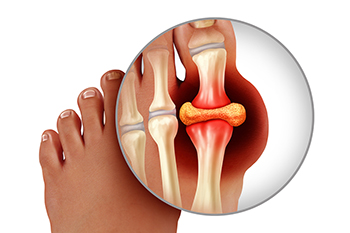
A common form of inflammatory arthritis is known as gout. It can be extremely uncomfortable and can cause severe pain. It frequently affects the joints in the big toe, and may make walking difficult. Gout develops as a result of a buildup of uric acid, which may come from specific foods, including red meat and shellfish, as well as drinking alcoholic beverages. In addition to pain in the big toe, common symptoms can consist of swelling, redness, and lumps that are painless under the skin. Prevention methods include losing excess weight, avoiding foods that can trigger gout attacks, and eating foods high in vitamin C. Additionally, implementing a gentle exercise routine may help to manage gout. If you have this type of pain in your big toe, please speak with a podiatrist who can discuss prevention techniques and offer treatment solutions.
Gout is a foot condition that requires certain treatment and care. If you are seeking treatment, contact Dr. Thong V. Truong from California. Our doctor will treat your foot and ankle needs.
What Is Gout?
Gout is a type of arthritis caused by a buildup of uric acid in the bloodstream. It often develops in the foot, especially the big toe area, although it can manifest in other parts of the body as well. Gout can make walking and standing very painful and is especially common in diabetics and the obese.
People typically get gout because of a poor diet. Genetic predisposition is also a factor. The children of parents who have had gout frequently have a chance of developing it themselves.
Gout can easily be identified by redness and inflammation of the big toe and the surrounding areas of the foot. Other symptoms include extreme fatigue, joint pain, and running high fevers. Sometimes corticosteroid drugs can be prescribed to treat gout, but the best way to combat this disease is to get more exercise and eat a better diet.
If you have any questions please feel free to contact our office located in Chico, CA . We offer the newest diagnostic and treatment technologies for all your foot and ankle needs.
How to Protect Your Feet as You Age
Foot care gets more inconvenient for the elderly, sometimes because it is just hard to reach your feet, and other times because an underlying condition makes it nearly impossible. There are a few simple ways for the elderly to practice foot care. Because the fatty pads that protect the soles of the feet may have thinned, one way is to wear shoes that fit properly, provide adequate arch support and cushioning for your heels while also avoiding walking barefoot at home. Try not to sit with your feet hanging down for long periods, and instead, keep them elevated as often as possible, especially if you are less active. Exercising the feet and ankles is a good idea in order to keep the blood flowing and reduce swelling. Practice good skin care, such as keeping your feet clean and dry, applying moisturizer to prevent cracked heels, and having calluses removed. Trim toenails straight across, to avoid ingrown nails that can become infected. If your feet are uncommonly cold, seem numb, red, bruised or swollen on a regular basis, or if they have sores that do not heal properly, it is a good idea to consider regular visits to a podiatrist who can keep on top of these symptoms and provide proper treatment before they worsen.
Proper foot care is something many older adults forget to consider. If you have any concerns about your feet and ankles, contact Dr. Thong V. Truong from California. Our doctor can provide the care you need to keep you pain-free and on your feet.
The Elderly and Their Feet
As we age we start to notice many changes in our body, but the elder population may not notice them right away. Medical conditions may prevent the elderly to take notice of their foot health right away. Poor vision is a lead contributor to not taking action for the elderly.
Common Conditions
- Neuropathy – can reduce feeling in the feet and can hide many life-threatening medical conditions.
- Reduced flexibility – prevents the ability of proper toenail trimming, and foot cleaning. If left untreated, it may lead to further medical issues.
- Foot sores – amongst the older population can be serious before they are discovered. Some of the problematic conditions they may face are:
- Gouging toenails affecting nearby toe
- Shoes that don’t fit properly
- Pressure sores
- Loss of circulation in legs & feet
- Edema & swelling of feet and ankles
Susceptible Infections
Diabetes and poor circulation can cause general loss of sensitivity over the years, turning a simple cut into a serious issue.
If you have any questions please feel free to contact our office located in Chico, CA . We offer the newest diagnostic and treatment technologies for all your foot and ankle needs.
Baby’s First Shoes and Walking
 Many parents choose to have their babies wear shoes, despite the fact that research has indicated that shoes are unnecessary to wear until walking begins. At this time, the first shoes often consist of having a flexible and non-slip sole, in addition to fitting correctly. The shoe is ideal when it fits securely on the foot. This can be helpful in preventing stubbed toes, splinters, or broken toenails. There are certain foot conditions that children can develop that require the expertise of a podiatrist. If your child has ingrown toenails, walks on their toes, or doesn’t walk by 15 months, it is suggested that you schedule an appointment with a podiatrist.
Many parents choose to have their babies wear shoes, despite the fact that research has indicated that shoes are unnecessary to wear until walking begins. At this time, the first shoes often consist of having a flexible and non-slip sole, in addition to fitting correctly. The shoe is ideal when it fits securely on the foot. This can be helpful in preventing stubbed toes, splinters, or broken toenails. There are certain foot conditions that children can develop that require the expertise of a podiatrist. If your child has ingrown toenails, walks on their toes, or doesn’t walk by 15 months, it is suggested that you schedule an appointment with a podiatrist.
Making sure that your children maintain good foot health is very important as they grow. If you have any questions, contact Dr. Thong V. Truong of California. Our doctor can provide the care you need to keep you pain-free and on your feet.
Keeping Children's Feet Healthy
Having healthy feet during childhood can help prevent medical problems later in life, namely in the back and legs. As children grow, their feet require different types of care. Here are some things to consider...
Although babies do not walk yet, it is still very important to take care of their feet.
Avoid putting tight shoes or socks on his or her feet.
Allow the baby to stretch and kick his or her feet to feel comfortable.
As a toddler, kids are now on the move and begin to develop differently. At this age, toddlers are getting a feel for walking, so don’t be alarmed if your toddler is unsteady or ‘walks funny’.
As your child gets older, it is important to teach them how to take care of their feet.
Show them proper hygiene to prevent infections such as fungus.
Be watchful for any pain or injury.
Have all injuries checked by a doctor as soon as possible.
Comfortable, protective shoes should always be worn, especially at play.
If you have any questions please feel free to contact our office located in Chico, CA . We offer the newest diagnostic and treatment technologies for all your foot and ankle needs.
Causes of Overpronation
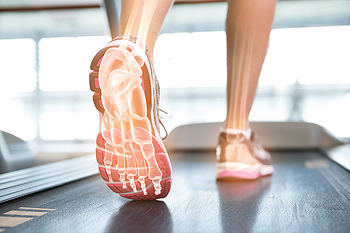 Overpronation refers to the feet rolling excessively inward during walking or running. This results in more weight being placed on the inner side of the foot, which can eventually cause foot pain, plantar fasciitis, ankle injuries, shin splints, stress fractures, and more. Overpronation itself usually has a gradual onset and can be caused by a variety of biomechanical distortions in the foot and ankle. These include having flat feet, knock knees, excess weight, or weakness in the tibialis posterior muscle or the ligaments that support the feet. If you are suffering from foot pain, please seek the care of a podiatrist.
Overpronation refers to the feet rolling excessively inward during walking or running. This results in more weight being placed on the inner side of the foot, which can eventually cause foot pain, plantar fasciitis, ankle injuries, shin splints, stress fractures, and more. Overpronation itself usually has a gradual onset and can be caused by a variety of biomechanical distortions in the foot and ankle. These include having flat feet, knock knees, excess weight, or weakness in the tibialis posterior muscle or the ligaments that support the feet. If you are suffering from foot pain, please seek the care of a podiatrist.
If you have any concerns about your feet, contact Dr. Thong V. Truong from California. Our doctor can provide the care you need to keep you pain-free and on your feet.
Biomechanics in Podiatry
Podiatric biomechanics is a particular sector of specialty podiatry with licensed practitioners who are trained to diagnose and treat conditions affecting the foot, ankle and lower leg. Biomechanics deals with the forces that act against the body, causing an interference with the biological structures. It focuses on the movement of the ankle, the foot and the forces that interact with them.
A History of Biomechanics
- Biomechanics dates back to the BC era in Egypt where evidence of professional foot care has been recorded.
- In 1974, biomechanics gained a higher profile from the studies of Merton Root, who claimed that by changing or controlling the forces between the ankle and the foot, corrections or conditions could be implemented to gain strength and coordination in the area.
Modern technological improvements are based on past theories and therapeutic processes that provide a better understanding of podiatric concepts for biomechanics. Computers can provide accurate information about the forces and patterns of the feet and lower legs.
Understanding biomechanics of the feet can help improve and eliminate pain, stopping further stress to the foot.
If you have any questions please feel free to contact our office located in Chico, CA . We offer the newest diagnostic and treatment technologies for all your foot and ankle needs.
Treatment for Foot Ulcers Caused by Diabetes
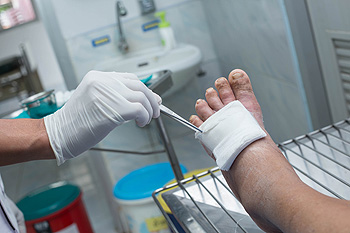 People with diabetes often develop peripheral neuropathy, caused by damaged nerves that make the feet numb. This condition often results in the inability of the diabetic to feel pain in the foot or toes. Cuts and sores that go unnoticed can take a long time to heal and eventually form into ulcers. When this happens, the health of the diabetic is at risk, as the ulcers can lead to gangrene or even limb loss in extreme cases. One way to treat the ulcers is with a total contact cast which is designed to protect the skin by placing a layer of foam between the foot and the plastic shell of the cast. As a result, the pressure is taken off the ulcer and gives it a chance to heal. This process can take up to 8 weeks. If you have neuropathy and notice sores on your feet that are not healing, it is suggested that you make an appointment with a podiatrist who can examine your feet and offer treatment options.
People with diabetes often develop peripheral neuropathy, caused by damaged nerves that make the feet numb. This condition often results in the inability of the diabetic to feel pain in the foot or toes. Cuts and sores that go unnoticed can take a long time to heal and eventually form into ulcers. When this happens, the health of the diabetic is at risk, as the ulcers can lead to gangrene or even limb loss in extreme cases. One way to treat the ulcers is with a total contact cast which is designed to protect the skin by placing a layer of foam between the foot and the plastic shell of the cast. As a result, the pressure is taken off the ulcer and gives it a chance to heal. This process can take up to 8 weeks. If you have neuropathy and notice sores on your feet that are not healing, it is suggested that you make an appointment with a podiatrist who can examine your feet and offer treatment options.
Diabetic foot care is important in preventing foot ailments such as ulcers. If you are suffering from diabetes or have any other concerns about your feet, contact Dr. Thong V. Truong from California. Our doctor can provide the care you need to keep you pain-free and on your feet.
Diabetic Foot Care
Diabetes affects millions of people every year. The condition can damage blood vessels in many parts of the body, especially the feet. Because of this, taking care of your feet is essential if you have diabetes, and having a podiatrist help monitor your foot health is highly recommended.
The Importance of Caring for Your Feet
- Routinely inspect your feet for bruises or sores.
- Wear socks that fit your feet comfortably.
- Wear comfortable shoes that provide adequate support.
Patients with diabetes should have their doctor monitor their blood levels, as blood sugar levels play such a huge role in diabetic care. Monitoring these levels on a regular basis is highly advised.
It is always best to inform your healthcare professional of any concerns you may have regarding your feet, especially for diabetic patients. Early treatment and routine foot examinations are keys to maintaining proper health, especially because severe complications can arise if proper treatment is not applied.
If you have any questions please feel free to contact our office located in Chico, CA . We offer the newest diagnostic and treatment technologies for all your foot and ankle needs.
Why It Is Important to Trim Your Toenails Properly
You may have heard that toenails should be trimmed straight across (as opposed to rounded) and that they should not be too short. Maintaining your toenails in this way will help avoid the toenail from growing into the skin surrounding it, which can lead to an ingrown toenail. Aside from improper toenail trimming, it is believed that wearing shoes that are too narrow in the toe box or are too short—causing your big toe to rub against the tip—can sometimes lead to an ingrown toenail. While an ingrown toenail may not cause any symptoms at first, in time it may become painful, red, swollen, and possibly infected. Pus may even collect under the nail and then drain. If you have an ingrown toenail, it is suggested that you seek the professional care of a podiatrist as soon as possible while treatment methods are typically more simple.
Ingrown toenails can become painful if they are not treated properly. For more information about ingrown toenails, contact Dr. Thong V. Truong of California. Our doctor can provide the care you need to keep you pain-free and on your feet.
Ingrown Toenails
Ingrown toenails occur when a toenail grows sideways into the bed of the nail, causing pain, swelling, and possibly infection.
Causes
- Bacterial infections
- Improper nail cutting such as cutting it too short or not straight across
- Trauma to the toe, such as stubbing, which causes the nail to grow back irregularly
- Ill-fitting shoes that bunch the toes too close together
- Genetic predisposition
Prevention
Because ingrown toenails are not something found outside of shoe-wearing cultures, going barefoot as often as possible will decrease the likeliness of developing ingrown toenails. Wearing proper fitting shoes and using proper cutting techniques will also help decrease your risk of developing ingrown toenails.
Treatment
Ingrown toenails are a very treatable foot condition. In minor cases, soaking the affected area in salt or antibacterial soaps will not only help with the ingrown nail itself, but also help prevent any infections from occurring. In more severe cases, surgery is an option. In either case, speaking to your podiatrist about this condition will help you get a better understanding of specific treatment options that are right for you.
If you have any questions please feel free to contact our office located in Chico, CA . We offer the newest diagnostic and treatment technologies for all your foot and ankle needs.
Understanding Gout
Gout is a type of inflammatory arthritis where excess amounts of uric acid causes hard crystals to form in the joints—most commonly affected is the big toe joint. The body’s inability to flush uric acid may be caused by kidney disease, diabetes, high blood pressure, obesity, certain medications, consuming foods and beverages that are high in purines, and a family history of gout. The pain felt by gout can often be acute, and may be accompanied by a burning sensation, swelling, and severe tenderness in the big toe. A podiatrist can diagnose gout through an examination, blood tests and analysis of joint fluid, and create a treatment plan based on their findings and the severity of the condition in the patient.
Gout is a painful condition that can be treated. If you are seeking treatment, contact Dr. Thong V. Truong from California. Our doctor will treat your foot and ankle needs.
What Is Gout?
Gout is a form of arthritis that is characterized by sudden, severe attacks of pain, redness, and tenderness in the joints. The condition usually affects the joint at the base of the big toe. A gout attack can occur at any random time, such as the middle of the night while you are asleep.
Symptoms
- Intense Joint Pain - Usually around the large joint of your big toe, and it most severe within the first four to twelve hours
- Lingering Discomfort - Joint discomfort may last from a few days to a few weeks
- Inflammation and Redness -Affected joints may become swollen, tender, warm and red
- Limited Range of Motion - May experience a decrease in joint mobility
Risk Factors
- Genetics - If family members have gout, you’re more likely to have it
- Medications - Diuretic medications can raise uric acid levels
- Gender/Age - Gout is more common in men until the age of 60. It is believed that estrogen protects women until that point
- Diet - Eating red meat and shellfish increases your risk
- Alcohol - Having more than two alcoholic drinks per day increases your risk
- Obesity - Obese people are at a higher risk for gout
Prior to visiting your podiatrist to receive treatment for gout, there are a few things you should do beforehand. If you have gout you should write down your symptoms--including when they started and how often you experience them, important medical information you may have, and any questions you may have. Writing down these three things will help your podiatrist in assessing your specific situation so that he or she may provide the best route of treatment for you.
If you have any questions, please feel free to contact our office located in Chico, CA . We offer the newest diagnostic and treatment technologies for all your foot care needs.
